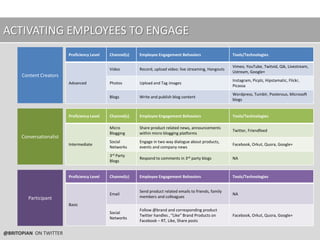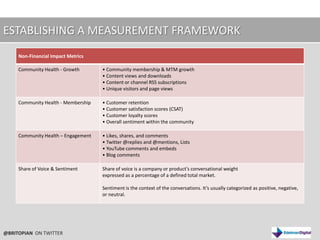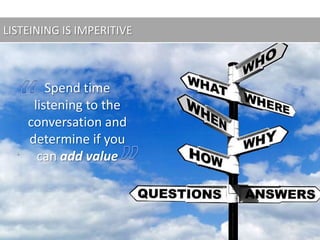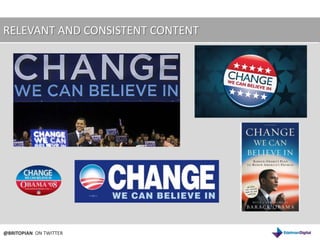Social Business Planning for Thomson Reuters
- 1. FROM SOCIAL BRAND TO SOCIAL BUSINESSMICHAEL BRITO | SVP, SOCIAL BUSINESS PLANNINGEDELMAN DIGITAL | @BRITOPIAN ON TWITTER
- 2. THE EVOLUTION OF SOCIAL BUSINESS2008 to presentTHE EVOLUTION OF SOCIAL BUSINESSSOCIAL BUSINESS2003 to present SOCIAL BRAND1995 to present SOCIAL CUSTOMERTechnology Innovation gives customers a voice
- 4. Amplified voice across the social web
- 5. Google indexing critical conversations about companies
- 6. Social Customers are trusted amongst their peers as influence grows
- 7. Companies and brands join Twitter, Facebook and create corporate blogs
- 8. Engage with the social customer in various channels
- 9. Social Media teams are forming slowly
- 10. Small budgets are allocated on a project basis to social media engagement and community building
- 11. Organizations begin humanizing business operations
- 12. Organizational models are formed to include social media
- 13. Organizational silos are torn down between internal teams
- 14. Governance models and social media policies are created
- 15. Social becomes an essential attribute of organizational culture@BRITOPIAN ON TWITTER
- 16. HOW DOES THE SOCIAL CUSTOMER BEHAVE?The customer journey is dynamic; and always changes
- 17. Brands need to have multiple customer touch points to break through the clutter
- 18. Customers need to hear things 3 – 5 times before the actually believe@BRITOPIAN ON TWITTER
- 19. THE SOCIAL CUSTOMER AND BRAND EXPERIENCEThe Informed(e.g. research products online)Brand Discovery:Google Search, Word of MouthThe Participant(e.g. participate in a brand experience)The Opinion Sharer(e.g. post review)Brand Participation:Fanning, following, likingBrand Sharing:Easy, habitual, publishingThe Advocate (e.g. encourage friends to purchase)Brand Advocacy:Creating content, sharing, defending@BRITOPIAN ON TWITTER
- 20. THE NEW PURCHASE FUNNELA brand should build relationships with the social customer on order to drive advocacy
- 21. Advocates talk about the brand, even when the brand isn’t listening
- 22. Advocates are trusted among their peers and within their micro communities
- 23. Advocates are aiding and influencing others down the purchase funnel
- 24. The reach of one advocate is minimal; as an aggregate, the total reach can make a strong business impact@BRITOPIAN ON TWITTER
- 25. 2011 GLOBAL SNAPHOT OF THE SOCIAL CUSTOMEREUROPE (EMEA)31% comment on blogs27% comment in forums20% uploaded a video online39% uploaded a photo online63% watch a video online13% actively blogLATIN AMERICA49% comment on blogs35% comment in forums41% uploaded a video online56% uploaded a photo online74% watch a video online27% actively blogASIA PACIFIC42% comment on blogs43% comment in forums29% uploaded a video online50% uploaded a photo online65% watch a video online37% actively blog@BRITOPIAN ON TWITTER
- 26. DEFINING A SOCIAL BRAND“A social brand is any company, product, individual, politician that uses social technologies in order to communicate with the social customer, their partners and constituencies or the general public. @BRITOPIAN ON TWITTER
- 27. ORGANIZATIONS FOCUSING ON INTERNAL CHANGEThe social brand has caused chaos and organizational anarchy in many companies today
- 28. Employees are running wild on the intrawebs with little to no guidance, direction or governance
- 29. Different geographies and business units are creating social communities externally and not sharing or communicating internally @BRITOPIAN ON TWITTER
- 30. USHERING IN SOCIAL BUSINESSA social business is built upon three pillars – people, process and technology
- 31. Change management and culture change is essential in order for genuine social business transformation to occur
- 32. Organizations cannot have effective external conversations with customers unless they can have effective, internal conversations with each other first@BRITOPIAN ON TWITTER
- 33. SOCIAL BUSINESS DEFINED“A social business is any company that has integrated and operationalized social media within every job function (and process) internally.@BRITOPIAN ON TWITTER
- 34. UNDERSTANDING THE DIFFERENCE@BRITOPIAN ON TWITTER
- 35. COMMON ORGANIZATIONAL MODELS - CENTRALIZEDIn a centralized organizational model, the “social media” job function is usually owned by corporate communications
- 36. Little to no collaboration between corp com and other marketing organizations and business units
- 38. No social media policies that empower employees to engage externally @BRITOPIAN ON TWITTER
- 39. COMMON ORGANIZATIONAL MODELS - DECENTRALIZEDIn a decentralized organizational model, the “social media” job function is scattered – everyone is doing it
- 40. Many decentralized organizations are a natural result of silos
- 41. Little tono collaboration or best practice sharing is happening
- 42. Loose social media policies exist but rarely enforced
- 43. Confusion about roles and responsibilities and conflict about “who owns” social media @BRITOPIAN ON TWITTER
- 44. FULLY COLLABORATIVE SOCIAL BUSINESS MODELA governing body, usually a “Center of Excellence” exists that is responsible for governance and strategic insights
- 45. Responsible for sharing best practices and technology recommendations with regions and other business units
- 46. Geographies and business units will execute external social media programs@BRITOPIAN ON TWITTER
- 47. FROM CHAOS TO GOVERNANCE@BRITOPIAN ON TWITTER
- 48. FROM CHAOS TO GOVERNANCE@BRITOPIAN ON TWITTER
- 49. CREATE A PARTICIPATORY LEARNING ORGANIZATIONTraining CurriculumAdvanced tactics of Community Engagement and Management
- 50. Leveraging search to create social content for blogs
- 51. Metrics deep dive – understanding metrics and making data driven decisions
- 52. Advanced training on social tools and technologies like Radian6, Meltwater Buzz, Sprinklr, Shoutlet, CoTweet, and other publishing/listening platforms
- 53. Train the trainerTraining CurriculumBasics of Community Engagement
- 54. Listening & Monitoring Tools and Apps
- 55. Intended Uses of Social Media
- 56. Engagement Model &Escalation Process
- 57. Metrics OverviewTraining CurriculumBasics of Social Media
- 58. Overview of owned media channels to include enterprise communities, blogs, Facebook and Twitter accounts
- 59. Policies & GuidelinesWHITE BELTAwareness & EngagementBLUE BELTFluency & ParticipationBLACK BELTExpertise & OwnershipOrganizational ExpectationsOrganizational ExpectationsOrganizational ExpectationsResearch & monitoring
- 60. Listening to owned media channels
- 61. Escalate conversations to others
- 62. Frequent tweeting and retweeting; responding to comments on/off of enterprise owned media channels
- 63. Responding to customer support issues and escalating to appropriate channels
- 65. Frequent blogging, tweeting and responding to comments on/off of enterprise owned media channels
- 66. Solving customer support issues on and off enterprise owned media channels
- 67. Mentoring and training white and blue belts; team brown bags
- 69. Participate in and attend bi-weekly social media integrations forumsFrom participation to complete ownership
- 70. ACTIVATING EMPLOYEES TO ENGAGEContent CreatorsConversationalistParticipant@BRITOPIAN ON TWITTER
- 71. ESTABLISHING A CONTENT LIBRARYEstablish a content library that serves as a repository of product related content; filtered and categorized by date and products
- 72. Optimized to make sharing very easy and convenient
- 73. The Library can live on Intranet and linked off from the home page of the site
- 74. Internal “share” links can be tagged to measure clicks and get a snap shot of employee sharing behavior@BRITOPIAN ON TWITTER
- 75. ESTABLISHING A MEASUREMENT FRAMEWORK@BRITOPIAN ON TWITTER
- 76. ESTABLISHING A MEASUREMENT FRAMEWORK@BRITOPIAN ON TWITTER
- 77. ESTABLISHING A CONTENT MARKETING PLAN
- 78. CONTENT STATEGY FRAMEWORKInternal ListeningCorporate Communications | Internal Communications | Product Organizations | Customer SupportExternal ListeningExisting Social Media Engagement | News Articles | Online Monitoring | Search @BRITOPIAN ON TWITTER
- 79. LISTEINING IS IMPERITIVE“Spend time listening to the conversation and determine if you can add value“
- 80. CONVERSATIONAL AUDIT…this tells you “where” the conversation is happening about the brand@BRITOPIAN ON TWITTER
- 81. TOPICAL CONVERSATIONAL AUDIT… this tells you how relevant your brand is within certain online conversations@BRITOPIAN ON TWITTER
- 82. RELEVANT AND CONSISTENT CONTENT@BRITOPIAN ON TWITTER
- 83. SOLVING CUSTOMER PROBLEMSIt’s one thing to solve individual customer issues. It’s another to fix the ROOT CAUSE of the problem!
- 84. REAL TIME ANALYTICSKnowing what content is being share/liked/RT’d the most should help drive the content strategy@BRITOPIAN ON TWITTER
- 85. DON’T FORGET ABOUT GOOGLEUnderstanding search behavior will help create editorial content@BRITOPIAN ON TWITTER
- 86. KNOWING “WHEN” TO POST CONTENT@BRITOPIAN ON TWITTER
- 87. OPTIMIZING THE HUB & SPOKESFacebook status updates that promote blog content
- 88. Other content shared NEEDS to add value to the conversation and community
- 89. Optimize Youtube channel and new videos to link back hub/blog
- 90. Videos can be shared on Facebook, YouTube or through editorialThe HubThe content hub is the website, blog, content aggregator
- 91. Content should be optimized for search w/terms that are relevant to your business
- 92. Should be convenient for users to consume content within the channels that they are comfortable with
- 93. Occasional tweets on promoting blog content
- 94. Cross promoting other social channels, when relevant
- 95. Needs to be unique; not the same on FB
- 96. Optimize Google+ page with relevant links and content back to other channels
- 97. Should not duplicate content
- 98. Add Google+ icons to hub@BRITOPIAN ON TWITTER
- 99. ?WHY DOES ALL THIS MATTER?
- 100. ALIGNMENT = BUSINESS RESULTSProgramsCommunity ManagementMarketingCustomer ServiceCommunicationsEventsCampaignsAdvocacyCrisisSOCIAL BRAND (External)SOCIAL BUSINESS (Internal)MEASURABLE OUTCOMESTrainingProcessCollaborationOrganization ModelsResearch & DevelopmentPolicies & GuidelinesKnowledge SharingCultureInfographic by @armano@BRITOPIAN ON TWITTERInfrastructure
- 101. SOCIAL BUSINESS VALUE CREATION MODELSalesAdvocacyProduct FeedbackCustomer SatisfactionValue CreationSocial listeningWorkflow/ProcessEngagementProduct DiscountsRelevant ContentSolving customer issuesBrand EnablementProduct InnovationProcess Improvement@BRITOPIAN ON TWITTER
- 102. THANK YOU!




































